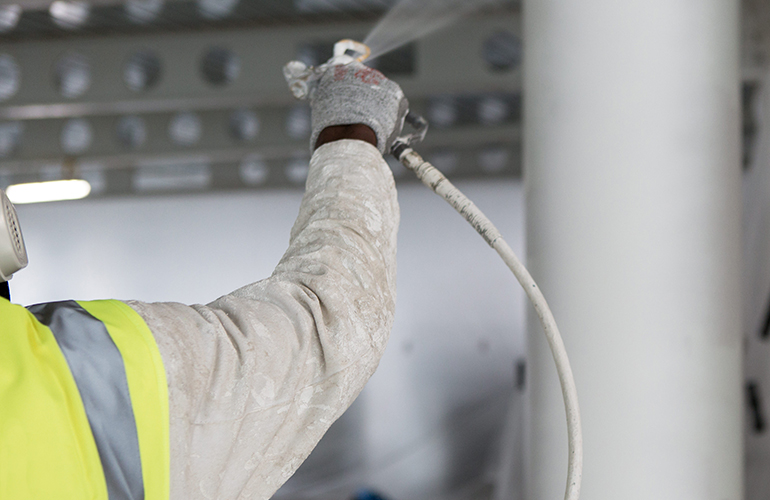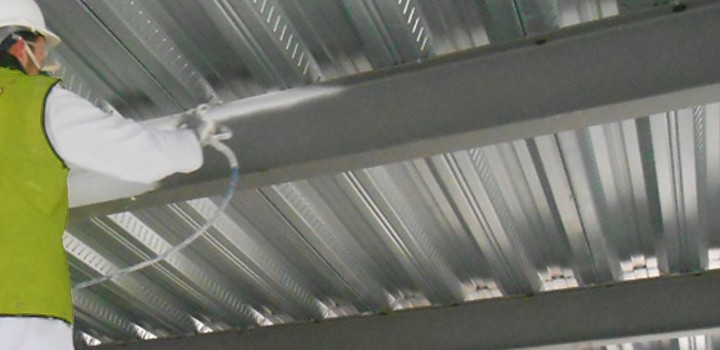Intumescent paint offers a modern alternative to conventional fireproofing methods in both residential and commercial construction. While traditional fireproofing materials such as cementitious coatings and fire-retardant boards have been widely used, expert intumescent paint service provides a thinner, more flexible, and aesthetically compatible solution. It expands when exposed to high heat, forming an insulating barrier that delays structural damage. This article explores why more architects, engineers, and contractors are choosing intumescent coatings over traditional systems.
How Intumescent Paint Works
Understanding the performance of intumescent coatings begins with how they function under heat exposure. These paints are not just surface finishes—they chemically transform during a fire event to provide a protective layer that shields structural elements from extreme temperatures.
Expansion Mechanism
- Under high temperatures (around 350°F and above), intumescent paint expands 15 to 50 times its original thickness.
- This expanded char layer reduces heat transfer to structural components.
Chemical Composition
- Typically includes a carbon source (char former), an acid source (catalyst), and a blowing agent.
- These ingredients activate sequentially to create an effective insulating layer.
Application Surface Compatibility
- Commonly used on structural steel, wood, gypsum, and some concrete assemblies.
- Works best on clean, primed surfaces and requires specific curing conditions.
Intumescent Paint vs. Traditional Fireproofing
Selecting the right fireproofing system involves understanding how intumescent coatings compare to cementitious or fibrous materials. These differences influence design, scheduling, safety performance, and overall aesthetics.
Thickness and Appearance
- Intumescent coatings provide fire resistance in thin layers.
- Cementitious coatings are bulkier, often several inches thick.
- Thinner application allows for architectural visibility and design continuity.
Weight and Structural Load
- Cementitious fireproofing adds significant dead weight to structures.
- Intumescent coatings are lightweight, reducing structural strain.
Durability and Maintenance
- Intumescent coatings resist cracking and flaking.
- Cementitious materials often degrade in high-moisture or vibration-prone environments.
- Intumescent systems require less maintenance over time.
Comparison Table
| Feature | Intumescent Paint | Cementitious Fireproofing |
|---|---|---|
| Application Thickness | Thin (1–5 mm) | Thick (up to 50 mm) |
| Aesthetic Compatibility | High | Low |
| Weight Load | Minimal | Heavy |
| Water Resistance | Moderate to High | Low |
| Crack Resistance | High | Moderate |
| Fire Resistance Rating | Up to 3 hours (UL) | Up to 3 hours (UL) |
Key Benefits for Residential and Commercial Projects
Beyond structural safety, intumescent coatings provide flexibility for designers and efficiency for contractors. These benefits make them suitable for various construction environments—from compact residential units to expansive commercial complexes.
Space Efficiency in Tight Conditions
- Allows fireproofing without enlarging wall or ceiling assemblies.
- Ideal for apartments, offices, and utility rooms with limited space.
Enhanced Aesthetic Control
- Can be painted over to match interior or exterior finishes.
- Does not compromise architectural detailing.
Versatility Across Material Types
- Applicable on metal beams, wood framing, and wall partitions.
- Useful in mixed-material assemblies.
Reduced Installation Time
- Applied via spraying or brushing in fewer layers than other fireproofing systems.
- Faster curing times accelerate construction schedules.
Common Uses in Structural Systems
Code-compliant construction projects frequently use intumescent coatings in high-risk or highly visible areas. Their compatibility with various substrates and fire rating performance makes them a reliable choice for both new builds and retrofits.
Structural Steel Protection
- Meets fire resistance ratings without the bulk of wrap systems.
- Maintains visibility of exposed steel in architectural designs.
Wood Frame Construction
- Enhances fire performance of traditional stick-frame buildings.
- Used in townhomes, garden-style apartments, and commercial wood-frame projects.
Retrofit Projects
- Ideal for upgrading existing structures where space and aesthetics matter.
- Reduces the need for costly fire-rated rebuilds.
Limitations and Considerations
Understanding the constraints of intumescent paint ensures proper planning and application. While highly effective, these coatings depend on the right product selection, surface prep, and environmental protection.
Environmental Exposure
- Not ideal for unprotected exterior use unless formulated for outdoor durability.
- Requires compatible primers and topcoats for UV and moisture protection.
Application Conditions
- Requires surface prep and appropriate ambient conditions for curing.
- May not adhere well to contaminated or porous surfaces.
Cost Implications
- Generally higher material cost than cementitious coatings.
- Labor costs may be offset by faster installation and reduced cleanup.
Conclusion
Intumescent paint provides a technically effective and visually compatible solution for fireproofing in modern construction. Its thin profile, minimal added weight, and ability to conform to complex architectural forms make it a preferred option for builders and property owners aiming for both safety and design continuity. While the upfront cost may be higher, long-term performance and reduced maintenance often justify the investment.
By choosing the right intumescent system for a specific building type and exposure environment, professional insulation contractors can meet fire safety regulations without compromising aesthetics or construction timelines.
FAQs
How long does intumescent paint last? Most systems last 10–20 years with proper maintenance and environmental protection. Re-coating may be needed depending on wear and exposure.
Can intumescent paint be used outdoors? Yes, but only with formulations rated for exterior exposure and paired with UV-protective topcoats.
Does intumescent paint meet building code requirements? Many intumescent coatings are UL-rated and meet ASTM E119 or similar standards required by code for fire-resistive assemblies.
Is intumescent paint better than drywall or other passive systems? It depends on the application. Intumescent paint is more space-efficient and aesthetically adaptable but may not replace all fire-rated assemblies.
What surfaces can it be applied to? It can be applied to steel, wood, gypsum, and some types of concrete, provided proper primers are used.
Author
Bob Gasca attended his first spray foam training in 2007 and has continued to pursue yearly training to stay current with the latest technology and practices. He is a certified Spray Foam Master Installer through the SPFA and a member of the SPFA. Additionally, Bob serves as a Spray Foam Worldwide Ambassador, sharing information with spray foam professionals globally. Recently, he returned from a building science training, where he expanded his knowledge on how weather conditions affect home performance, helping him better diagnose and improve home health for families. Bob specializes in finding solutions to complex moisture and air infiltration issues.
Reviewer
Noah Gonzalez reviewed this article and drew on 9 years of experience to offer suggestions that make the guidance more directly useful for insulation contractors.

